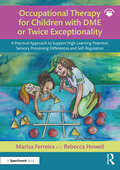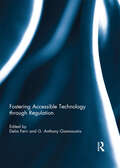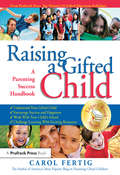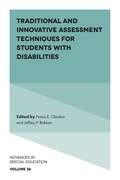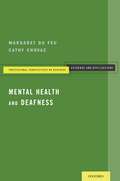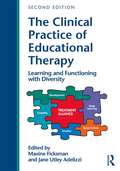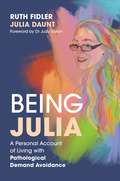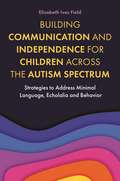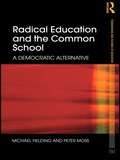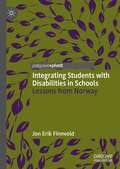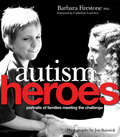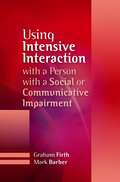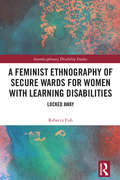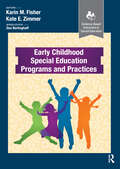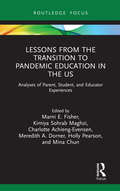- Table View
- List View
Occupational Therapy for Children with DME or Twice Exceptionality: A Practical Approach to Support High Learning Potential, Sensory Processing Differences and Self-Regulation
by Mariza Ferreira Rebecca HowellChildren with high learning potential or giftedness have remarkable potential. Despite this, these children can struggle to participate in everyday life because of a range of needs that are sometimes misunderstood, overlooked or not adequately addressed, leading to underachievement and, in turn, low self-esteem. Needs that, in many cases, paediatric occupational therapists are best suited to address. The practical resource offered in the book, the DME-C approach, is a tried-and-tested approach to help children who have challenges relating to their high learning potential, as well as sensory processing differences, unhelpful thought patterns and self-regulation. It draws on the heart of occupational therapy that considers the whole profile of the child, actively caters to the unique profiles of children with dual or multiple exceptionality (DME) or twice exceptionality (2e), and guides therapists towards therapy provision that is strengths-based and achieves favourable outcomes. This book: ● Includes a clear and comprehensive introduction to high learning potential and DME or twice exceptionality (2e), along with guidance to help identify children with these profiles. ● Covers questions and concerns occupational therapists may have when working with children with DME or 2e. ● Considers the similarities and differences between high learning potential/DME/2e and neurodivergent conditions such as developmental coordination disorder, autism and ADHD, with a focus on sensory processing differences. ● Explains, in easy-to-understand language, the full DME-C therapy approach, with a range of example activities to use in therapy to achieve its principles, and a suggested therapy progression plan. ● Is packed full of real-life case studies to translate theory into practice. ● Empowers therapists and educational professionals further by drawing attention to how they can better relate to children with DME/2e in therapy regardless of the children’s specific needs. Full of examples and with the voices of parents and children at its heart, this resource is essential reading for occupational therapists, SENCOs, education psychologists and other relevant professionals, who want to improve the lives and wellbeing of children with DME or twice exceptionality and help them reach their full potential.
Occupational Therapy for Children with DME or Twice Exceptionality: A Practical Approach to Support High Learning Potential, Sensory Processing Differences and Self-Regulation
by Mariza Ferreira Rebecca HowellChildren with high learning potential or giftedness have remarkable potential. Despite this, these children can struggle to participate in everyday life because of a range of needs that are sometimes misunderstood, overlooked or not adequately addressed, leading to underachievement and, in turn, low self-esteem. Needs that, in many cases, paediatric occupational therapists are best suited to address. The practical resource offered in the book, the DME-C approach, is a tried-and-tested approach to help children who have challenges relating to their high learning potential, as well as sensory processing differences, unhelpful thought patterns and self-regulation. It draws on the heart of occupational therapy that considers the whole profile of the child, actively caters to the unique profiles of children with dual or multiple exceptionality (DME) or twice exceptionality (2e), and guides therapists towards therapy provision that is strengths-based and achieves favourable outcomes. This book: ● Includes a clear and comprehensive introduction to high learning potential and DME or twice exceptionality (2e), along with guidance to help identify children with these profiles. ● Covers questions and concerns occupational therapists may have when working with children with DME or 2e. ● Considers the similarities and differences between high learning potential/DME/2e and neurodivergent conditions such as developmental coordination disorder, autism and ADHD, with a focus on sensory processing differences. ● Explains, in easy-to-understand language, the full DME-C therapy approach, with a range of example activities to use in therapy to achieve its principles, and a suggested therapy progression plan. ● Is packed full of real-life case studies to translate theory into practice. ● Empowers therapists and educational professionals further by drawing attention to how they can better relate to children with DME/2e in therapy regardless of the children’s specific needs. Full of examples and with the voices of parents and children at its heart, this resource is essential reading for occupational therapists, SENCOs, education psychologists and other relevant professionals, who want to improve the lives and wellbeing of children with DME or twice exceptionality and help them reach their full potential.
Fostering Accessible Technology through Regulation
by Delia Ferri G. Anthony GiannoumisTechnology has attracted an increasing level of attention within studies of disability and disability rights. Many researchers and advocates have maintained skepticism towards technology out of the fear that technology becomes another way to ‘fix’ impairments. These skeptical views, however, contrast with a more positive approach towards the role that technology can play in eliminating barriers to social participation. Legal scholarship has started to focus on accessibility and accessible technology and in conjunction with the recently adopted United Nations Convention on the Rights of Persons with Disabilities has put a great emphasis on accessibility, highlighting the role that accessible technology plays in the promotion and protection of the rights of people with disabilities. Against this background, this book gathers together different contributions that focus on enhancing the production, marketing and use of accessible technology. Building upon previous academic studies and in light of the UNCRPD, accessible technology is considered a tool to increase autonomy and participation. Overall, this book attempts to show, through a multifaceted and inter-disciplinary analysis, that different regulatory approaches might enhance accessible technology and its availability. This title was previously published as a special issue of the International Review of Law, Computers & Technology.
Raising a Gifted Child: A Parenting Success Handbook
by Carol FertigFrom the author of the nation's most popular blog on parenting gifted children comes the definitive how-to manual for parents, Raising a Gifted Child: A Parenting Success Handbook, a gifted education Legacy Award winner. Raising gifted children isn't easy, but when armed with the practical knowledge and tools in this exciting book, parents can navigate the maze of raising bright kids, leading to success in school and beyond. This book offers a large menu of strategies, resources, organizations, tips, and suggestions for parents to find optimal learning opportunities for their kids, covering the gamut of talent areas, including academics, the arts, technology, creativity, music, and thinking skills. The focus of this definitive resource is on empowering parents by giving them the tools needed to ensure that their gifted kids are happy and successful both in and out of school.Additional topics covered include volunteering at their child's school; different school options and specialty programs; tips for handling special circumstances; specific suggestions for each core content area; and strategies for finding the best resources for parents on the Web. This easy-to-read book is sure to be a favorite of parents of smart kids for years to come!Educational Resource
Raising a Gifted Child: A Parenting Success Handbook
by Carol FertigFrom the author of the nation's most popular blog on parenting gifted children comes the definitive how-to manual for parents, Raising a Gifted Child: A Parenting Success Handbook, a gifted education Legacy Award winner. Raising gifted children isn't easy, but when armed with the practical knowledge and tools in this exciting book, parents can navigate the maze of raising bright kids, leading to success in school and beyond. This book offers a large menu of strategies, resources, organizations, tips, and suggestions for parents to find optimal learning opportunities for their kids, covering the gamut of talent areas, including academics, the arts, technology, creativity, music, and thinking skills. The focus of this definitive resource is on empowering parents by giving them the tools needed to ensure that their gifted kids are happy and successful both in and out of school.Additional topics covered include volunteering at their child's school; different school options and specialty programs; tips for handling special circumstances; specific suggestions for each core content area; and strategies for finding the best resources for parents on the Web. This easy-to-read book is sure to be a favorite of parents of smart kids for years to come!Educational Resource
Traditional and Innovative Assessment Techniques for Students with Disabilities (Advances in Special Education #36)
by Festus E. Obiakor, Jeffrey P. BakkenIn order to properly understand and compare traditional and innovative assessment techniques for students with disabilities, we must be able to access examples of how they work in a logical and thoughtful sequence. This finely curated collection of thirteen chapters presents ideas and research on different disability topics from key leaders in the field of the assessment of children with disabilities. Written by well-known and respected researchers, scholars, and educators who are actively involved in teaching undergraduate and graduate special education courses on the assessment of students with disabilities, this volume opens with a thorough introduction on the current situation. The topics covered by the remaining chapters include students with learning and intellectual disabilities, emotional and behavioral disorders, sensory impairments, extensive support needs, traumatic brain injuries, and those who are culturally and linguistically diverse, autistic, and those who have physical disabilities. The concluding chapter muses on what the future holds for traditional and innovative assessment techniques for students with disabilities. This volume is an excellent resource for special education researchers, scholars, practitioners, and professionals who teach and serve young learners with disabilities.
The Clinical Practice of Educational Therapy: Learning and Functioning with Diversity
by Maxine Ficksman Jane Utley AdelizziDespite the wide array of services offered to students with learning disabilities, attention-deficit disorder, and a variety of comorbid conditions, large numbers of students are caught in the struggle of surviving school. Unfortunate school experiences may impact their sense of self and the degree of tenacity with which they pursue further training or challenging opportunities in the workplace. These are the people for whom educational therapy provides relief, enlightenment, and the coveted prize of success. The second edition of The Clinical Practice of Educational Therapy, the first textbook in its field, provides a comprehensive perspective of this interdisciplinary profession and practice, reaching out to a more global audience. The book describes the scope and practice of educational therapy from its European roots to its growing presence in the United States, providing readers with case studies and research that illustrate the work of educational therapists across the lifespan in diverse settings. Interdisciplinary Perspective — Other books focus on either educational or therapeutic interventions but rarely discuss the blend and synergy of disciplines (e.g., special education, neuropsychology, assessment, and social work) that are the hallmark of this unique profession. Illustrative Cases — The text draws heavily on case studies as a means of understanding the practice of educational therapy, especially the dynamic relationship that exists between therapist and client. Numerous charts and tables provide visuals for educational therapists as well as allied professionals, parents, and those with learning challenges. Expertise — The editors are both highly visible educational therapists. Chapter authors are either experienced educational therapists or allied professionals who have made scholarly contributions to the profession, such as Trisha Waters, Roslyn Arnold, and George McCloskey. In addition to benefiting educational therapists and students, this book is appropriate for professionals who work in related fields such as special education, regular education, school and educational psychology, neuropsychology, school counseling, psychology, speech and language pathology, art therapy, occupational therapy, and social work, as well as in medicine and psychiatry. NEW TO THE SECOND EDITION The second edition of The Clinical Practice of Educational Therapy: Learning & Functioning with Diversity has revised and updated the chapters from the first edition, and added three new chapters which further define and broaden this field by exploring diverse perspectives: Chapter 10, "Cultivating Character Development: Educational Therapy’s Impact on Individuals, Families, Schools, Educational Policy, and Society" by Maxine Ficksman Chapter 12, "Women and Girls Who Are Disenfranchised: A Global and Interdisciplinary Approach to Educational Therapy" by Jane Utley Adelizzi Chapter 17, "Examining the Efficacy of Graduate Programs in Educational Therapy at California State University, Northridge (CSUN): Educational Therapy Intern, Graduate and Parent Perspectives" by Marcy Dann, Nancy Burstein, Tamarah Ashton, and Sue Sears. These additional chapters, supported by brain-based research, characterize the shifts and changes experienced in a range of settings. Through the treatment alliance, educational therapists address students’ and clients’ ability to experience a more comprehensive model of learning, dependent upon the psychological, social, emotional, cultural and academic environments. The three new chapters range in focus from formal research and graduate training in the field of educational therapy to students throughout the lifespan whose social and educational experiences require a careful eye to not only the academic task at hand but also to the ways in which they cope and adapt to a range of environments and challenges. Lastly, educational therapy’s empathic foundation in practice is exemplified when we consider the global experience of students who strive to learn in situations and settings that threaten their survival a
The Clinical Practice of Educational Therapy: Learning and Functioning with Diversity
by Maxine Ficksman Jane Utley AdelizziDespite the wide array of services offered to students with learning disabilities, attention-deficit disorder, and a variety of comorbid conditions, large numbers of students are caught in the struggle of surviving school. Unfortunate school experiences may impact their sense of self and the degree of tenacity with which they pursue further training or challenging opportunities in the workplace. These are the people for whom educational therapy provides relief, enlightenment, and the coveted prize of success. The second edition of The Clinical Practice of Educational Therapy, the first textbook in its field, provides a comprehensive perspective of this interdisciplinary profession and practice, reaching out to a more global audience. The book describes the scope and practice of educational therapy from its European roots to its growing presence in the United States, providing readers with case studies and research that illustrate the work of educational therapists across the lifespan in diverse settings. Interdisciplinary Perspective — Other books focus on either educational or therapeutic interventions but rarely discuss the blend and synergy of disciplines (e.g., special education, neuropsychology, assessment, and social work) that are the hallmark of this unique profession. Illustrative Cases — The text draws heavily on case studies as a means of understanding the practice of educational therapy, especially the dynamic relationship that exists between therapist and client. Numerous charts and tables provide visuals for educational therapists as well as allied professionals, parents, and those with learning challenges. Expertise — The editors are both highly visible educational therapists. Chapter authors are either experienced educational therapists or allied professionals who have made scholarly contributions to the profession, such as Trisha Waters, Roslyn Arnold, and George McCloskey. In addition to benefiting educational therapists and students, this book is appropriate for professionals who work in related fields such as special education, regular education, school and educational psychology, neuropsychology, school counseling, psychology, speech and language pathology, art therapy, occupational therapy, and social work, as well as in medicine and psychiatry. NEW TO THE SECOND EDITION The second edition of The Clinical Practice of Educational Therapy: Learning & Functioning with Diversity has revised and updated the chapters from the first edition, and added three new chapters which further define and broaden this field by exploring diverse perspectives: Chapter 10, "Cultivating Character Development: Educational Therapy’s Impact on Individuals, Families, Schools, Educational Policy, and Society" by Maxine Ficksman Chapter 12, "Women and Girls Who Are Disenfranchised: A Global and Interdisciplinary Approach to Educational Therapy" by Jane Utley Adelizzi Chapter 17, "Examining the Efficacy of Graduate Programs in Educational Therapy at California State University, Northridge (CSUN): Educational Therapy Intern, Graduate and Parent Perspectives" by Marcy Dann, Nancy Burstein, Tamarah Ashton, and Sue Sears. These additional chapters, supported by brain-based research, characterize the shifts and changes experienced in a range of settings. Through the treatment alliance, educational therapists address students’ and clients’ ability to experience a more comprehensive model of learning, dependent upon the psychological, social, emotional, cultural and academic environments. The three new chapters range in focus from formal research and graduate training in the field of educational therapy to students throughout the lifespan whose social and educational experiences require a careful eye to not only the academic task at hand but also to the ways in which they cope and adapt to a range of environments and challenges. Lastly, educational therapy’s empathic foundation in practice is exemplified when we consider the global experience of students who strive to learn in situations and settings that threaten their survival a
Being Julia - A Personal Account of Living with Pathological Demand Avoidance
by Ruth Fidler Julia DauntDiagnosed with Pathological Demand Avoidance (PDA) at aged 12 and writing this memoir at age 37, Julia Daunt depicts the ins and out of PDA and its symptoms, while maintaining a positive outlook on what is possible to achieve. Co-written with professional specialist Ruth Fidler, it covers how PDA impacts Julia's life, including meltdowns, sensory issues and communication in relationships.Including examples of school reports and handwritten letters, a chapter written from Julia's partner's perspective and even an example of Julia's favourite recipe, this warm and personal look at living and thriving with PDA is informative and inspiring.
Building Communication and Independence for Children Across the Autism Spectrum: Strategies to Address Minimal Language, Echolalia and Behavior
by Elizabeth FieldExpert author Elizabeth Ives Field combines over four decades of working in the autism field to provide functional, in-depth teaching strategies for children on the spectrum who struggle with communication. Incorporating descriptions of composite children at different developmental stages, this book sets out individual goals and therapy approaches for children who may have no speech, moderately functional speech or echolalia, as well as for highly verbal individuals who may not always use appropriate language. Covering a wide range of interventions that address communication and the related areas of independence and social behavior, the purpose of each goal is to make progress toward the child's maximum potential. This book sets out skills that are developmentally appropriate and that will be immediately useful to help children express themselves more effectively and build relationships with others.
Building Communication and Independence for Children Across the Autism Spectrum: Strategies to Address Minimal Language, Echolalia and Behavior
by Elizabeth FieldExpert author Elizabeth Ives Field combines over four decades of working in the autism field to provide functional, in-depth teaching strategies for children on the spectrum who struggle with communication. Incorporating descriptions of composite children at different developmental stages, this book sets out individual goals and therapy approaches for children who may have no speech, moderately functional speech or echolalia, as well as for highly verbal individuals who may not always use appropriate language. Covering a wide range of interventions that address communication and the related areas of independence and social behavior, the purpose of each goal is to make progress toward the child's maximum potential. This book sets out skills that are developmentally appropriate and that will be immediately useful to help children express themselves more effectively and build relationships with others.
Radical Education and the Common School: A Democratic Alternative (Foundations and Futures of Education)
by Michael Fielding Peter MossWhat is education, what is it for and what are its fundamental values? How do we understand knowledge and learning? What is our image of the child and the school? How does the ever more pressing need to develop a more just, creative and sustainable democratic society affect our responses to these questions? Addressing these fundamental issues, Fielding and Moss contest the current mainstream dominated by markets and competition, instrumentality and standardisation, managerialism and technical practice. They argue instead for a radical education with democracy as a fundamental value, care as a central ethic, a person-centred education that is education in the broadest sense, and an image of a child rich in potential. Radical education, they say, should be practiced in the ‘common school’, a school for all children in its local catchment area, age-integrated, human scale, focused on depth of learning and based on team working. A school understood as a public space for all citizens, a collective workshop of many purposes and possibilities, and a person-centred learning community, working closely with other schools and with local authorities. The book concludes by examining how we might bring such transformation about. Written by two of the leading experts in the fields of early childhood and secondary education, the book covers a wide vista of education for children and young people. Vivid examples from different stages of education are used to explore the full meaning of radical democratic education and the common school and how they can work in practice. It connects rich thinking and experiences from the past and present to offer direction and hope for the future. It will be of interest and inspiration to all who care about education - teachers and students, academics and policy makers, parents and politicians.
Radical Education and the Common School: A Democratic Alternative (Foundations and Futures of Education)
by Michael Fielding Peter MossWhat is education, what is it for and what are its fundamental values? How do we understand knowledge and learning? What is our image of the child and the school? How does the ever more pressing need to develop a more just, creative and sustainable democratic society affect our responses to these questions? Addressing these fundamental issues, Fielding and Moss contest the current mainstream dominated by markets and competition, instrumentality and standardisation, managerialism and technical practice. They argue instead for a radical education with democracy as a fundamental value, care as a central ethic, a person-centred education that is education in the broadest sense, and an image of a child rich in potential. Radical education, they say, should be practiced in the ‘common school’, a school for all children in its local catchment area, age-integrated, human scale, focused on depth of learning and based on team working. A school understood as a public space for all citizens, a collective workshop of many purposes and possibilities, and a person-centred learning community, working closely with other schools and with local authorities. The book concludes by examining how we might bring such transformation about. Written by two of the leading experts in the fields of early childhood and secondary education, the book covers a wide vista of education for children and young people. Vivid examples from different stages of education are used to explore the full meaning of radical democratic education and the common school and how they can work in practice. It connects rich thinking and experiences from the past and present to offer direction and hope for the future. It will be of interest and inspiration to all who care about education - teachers and students, academics and policy makers, parents and politicians.
Integrating Students with Disabilities in Schools: Lessons from Norway
by Jon Erik FinnvoldThis book explores the ability of the Norwegian school system to support the achievement of formal competencies among children with physical disabilities, as well as its role in the informal dimensions of social participation and networking. Schools contribute to social inclusion in several ways: they are arenas for building official competencies, ensuring future access and success in the labour market. They are also sites for meeting other children, and developing friendships – friendships are not only important for strengthening cognitive development, but are vital to both good mental health and the building of various forms of social capital. By examining schools and the ways in which inclusion is incorporated early, this book aims to bridge the opportunity and employment gap that people with physical disabilities are more likely to face later in life.
Autism Heroes: Portraits of Families Meeting the Challenge (PDF)
by Barbara Firestone Ted ColeIntimate, bold, and inspiring, Autism Heroes provides a compelling and sensitive account of the experiences of 38 families from different walks of life confronting the challenges of autism with courage, tenacity and love. With empathy and expertise gained from her three decades of leadership of The Help Group and commitment to children with special needs, Dr. Barbara Firestone engages the families in candid, powerful and deeply affecting conversations about their lives. Each family narrative is set against the backdrop of her insightful essays about dignity, hope, opportunity and love, which are fundamentally important to all families living with autism. The families offer their experiences openly and honestly, sharing their challenges, triumphs, and hopes. Their candor helps demystify and destigmatize autism and embraces other parents just beginning or already on the journey. Their reflections chart the course through the many stages of coping with autism and seeking solutions for their children, and they offer a lifeline of support, insight and encouragement and hope. Fully illustrated with stunning photographs by Joe Buissink, Autism Heroes is an invaluable resource for families as well as educators, clinicians, researchers and policy makers.
Using Intensive Interaction with a Person with a Social or Communicative Impairment
by Graham Firth Mark BarberIntensive Interaction is a highly effective approach for communicating and developing social interaction and engagement with difficult-to-reach individuals. This easy-to-use guide steers readers through the practical application of the approach, showing how positive results can best be achieved. The authors explain clearly how to prepare for, carry out and reflect on the use of Intensive Interaction with a client or family member. A multitude of key questions are addressed, including finding the right setting, evaluating progress and disengaging effectively at the end of a session. In the final section they consider some of the wider implications of the approach, such as developing confidence as a practitioner and incorporating Intensive Interaction into long-term care or educational planning. This practical and accessible book is a useful resource for speech and language therapists, occupational therapists, special school or further education teachers, social care professionals and anyone else caring for or working with people with social or communicative impairments. It will also be useful to practitioners already using the approach.
Using Intensive Interaction with a Person with a Social or Communicative Impairment (PDF)
by Graham Firth Mark BarberIntensive Interaction is a highly effective approach for communicating and developing social interaction and engagement with difficult-to-reach individuals. This easy-to-use guide steers readers through the practical application of the approach, showing how positive results can best be achieved. The authors explain clearly how to prepare for, carry out and reflect on the use of Intensive Interaction with a client or family member. A multitude of key questions are addressed, including finding the right setting, evaluating progress and disengaging effectively at the end of a session. In the final section they consider some of the wider implications of the approach, such as developing confidence as a practitioner and incorporating Intensive Interaction into long-term care or educational planning. This practical and accessible book is a useful resource for speech and language therapists, occupational therapists, special school or further education teachers, social care professionals and anyone else caring for or working with people with social or communicative impairments. It will also be useful to practitioners already using the approach.
Sehbehinderung und Arbeit: Rekonfigurationen im digitalen Kapitalismus (Gesellschaft der Unterschiede #68)
by Andrea Fischer-TahirEine Inklusion, die auf bedarfsgerechte Teilhabe am Niedriglohnsektor abzielt, steht im Kontrast zu den sozialen Interessen von Menschen mit Behinderung auf der Suche nach guter Arbeit. Andrea Fischer-Tahir setzt die Themen Behinderung, Digitalisierung und Arbeit in Bezug zueinander, ermittelt den Gebrauchswert assistiver Technologie und spürt den Rekonfigurationen von Lebensentwürfen nach. Anhand von Interviews und Fokusgruppen untersucht sie aus der Perspektive kritischer Sozialtheorie Möglichkeiten und Grenzen des digitalen Kapitalismus für Sehbehinderte und rekonstruiert Erfahrungen von Exklusion im beruflichen Feld sowie Machtverhältnisse in Inklusionsmaßnahmen.
Sehbehinderung und Arbeit: Rekonfigurationen im digitalen Kapitalismus (Gesellschaft der Unterschiede #68)
by Andrea Fischer-TahirEine Inklusion, die auf bedarfsgerechte Teilhabe am Niedriglohnsektor abzielt, steht im Kontrast zu den sozialen Interessen von Menschen mit Behinderung auf der Suche nach guter Arbeit. Andrea Fischer-Tahir setzt die Themen Behinderung, Digitalisierung und Arbeit in Bezug zueinander, ermittelt den Gebrauchswert assistiver Technologie und spürt den Rekonfigurationen von Lebensentwürfen nach. Anhand von Interviews und Fokusgruppen untersucht sie aus der Perspektive kritischer Sozialtheorie Möglichkeiten und Grenzen des digitalen Kapitalismus für Sehbehinderte und rekonstruiert Erfahrungen von Exklusion im beruflichen Feld sowie Machtverhältnisse in Inklusionsmaßnahmen.
A Feminist Ethnography of Secure Wards for Women with Learning Disabilities: Locked Away (Interdisciplinary Disability Studies)
by Rebecca FishWhat is life like for women with learning disabilities detained in a secure unit? This book presents a unique ethnographic study conducted in a contemporary institution in England. Rebecca Fish takes an interdisciplinary approach, drawing on both the social model of disability and intersectional feminist methodology, to explore the reasons why the women were placed in the unit, as well their experiences of day-to-day life as played out through relationships with staff and other residents. She raises important questions about the purpose of such units and the services they offer. Through making the women’s voices heard, this book presents their experiences and unique perspectives on topics such as seclusion, restraint, and resistance. Exploring how the ever present power disparity works to regulate women’s behaviour, the book shows how institutional responses replicate women’s bad experiences from the past, and how women’s responses are seen as pathological. It demonstrates that women are not passive recipients of care, but shape their own identity and futures, sometimes by resisting the norms expected of them (within allowed limits) and sometimes by transgressing the rules. These insights thus challenge traditional institutional accounts of gender, learning disability and deviance and highlight areas for reform in policy, practice, methodology, and social theory. This ground-breaking book will be of interest to scholars, students, policymakers and advocates working in the fields of learning disability and disability studies more widely, gender studies and sociology.
A Feminist Ethnography of Secure Wards for Women with Learning Disabilities: Locked Away (Interdisciplinary Disability Studies)
by Rebecca FishWhat is life like for women with learning disabilities detained in a secure unit? This book presents a unique ethnographic study conducted in a contemporary institution in England. Rebecca Fish takes an interdisciplinary approach, drawing on both the social model of disability and intersectional feminist methodology, to explore the reasons why the women were placed in the unit, as well their experiences of day-to-day life as played out through relationships with staff and other residents. She raises important questions about the purpose of such units and the services they offer. Through making the women’s voices heard, this book presents their experiences and unique perspectives on topics such as seclusion, restraint, and resistance. Exploring how the ever present power disparity works to regulate women’s behaviour, the book shows how institutional responses replicate women’s bad experiences from the past, and how women’s responses are seen as pathological. It demonstrates that women are not passive recipients of care, but shape their own identity and futures, sometimes by resisting the norms expected of them (within allowed limits) and sometimes by transgressing the rules. These insights thus challenge traditional institutional accounts of gender, learning disability and deviance and highlight areas for reform in policy, practice, methodology, and social theory. This ground-breaking book will be of interest to scholars, students, policymakers and advocates working in the fields of learning disability and disability studies more widely, gender studies and sociology.
Early Childhood Special Education Programs and Practices (Evidence-Based Instruction in Special Education)
by Karin Fisher Kate ZimmerEarly Childhood Special Education Programs and Practices is a special education textbook that prepares pre- and in-service teachers with the knowledge, skills, and dispositions to deliver evidence-based instruction to promote positive academic and behavioral outcomes for young children (prekindergarten through second grade) with development delays and/or disabilities.Early Childhood Special Education Programs and Practices intertwines inclusive early childhood practices by using real-life anecdotes to illustrate evidence-based practices (EBPs) and procedures. The authors, experts in their fields, emphasize high-leverage practices, EBPs, and culturally sustaining pedagogy and align them with the practices, skills, and competencies recommended by the Council for Exceptional Children’s Division for Early Childhood. Families, administrators, and teacher educators of pre- and in-service early childhood special education and general early childhood education programs alike will find this book useful.Included in Early Childhood Special Education Programs and Practices are: An overview of early childhood and development of children ages 4 to 8 Strategies for relationship building with students, families, communities, and school personnel Tips on creating a caring and positive classroom environment Chapters devoted to evidence-based instruction in core subjects of reading and writing, mathematics, science, and social studies for students with disabilities in pre-K to second grade More than 80 images, photos, tables, graphs, and case studies to illustrate recommended Practices Also included with the text are online supplemental materials for faculty use in the classroom, consisting of an Instructor’s Manual and PowerPoint slides.Created with the needs of early childhood special educators in mind, Early Childhood Special Education Programs and Practices provides pre- and in-service teachers with the skills and practices they need to serve young children, their families, and communities across settings.
Early Childhood Special Education Programs and Practices (Evidence-Based Instruction in Special Education)
by Karin Fisher Kate ZimmerEarly Childhood Special Education Programs and Practices is a special education textbook that prepares pre- and in-service teachers with the knowledge, skills, and dispositions to deliver evidence-based instruction to promote positive academic and behavioral outcomes for young children (prekindergarten through second grade) with development delays and/or disabilities.Early Childhood Special Education Programs and Practices intertwines inclusive early childhood practices by using real-life anecdotes to illustrate evidence-based practices (EBPs) and procedures. The authors, experts in their fields, emphasize high-leverage practices, EBPs, and culturally sustaining pedagogy and align them with the practices, skills, and competencies recommended by the Council for Exceptional Children’s Division for Early Childhood. Families, administrators, and teacher educators of pre- and in-service early childhood special education and general early childhood education programs alike will find this book useful.Included in Early Childhood Special Education Programs and Practices are: An overview of early childhood and development of children ages 4 to 8 Strategies for relationship building with students, families, communities, and school personnel Tips on creating a caring and positive classroom environment Chapters devoted to evidence-based instruction in core subjects of reading and writing, mathematics, science, and social studies for students with disabilities in pre-K to second grade More than 80 images, photos, tables, graphs, and case studies to illustrate recommended Practices Also included with the text are online supplemental materials for faculty use in the classroom, consisting of an Instructor’s Manual and PowerPoint slides.Created with the needs of early childhood special educators in mind, Early Childhood Special Education Programs and Practices provides pre- and in-service teachers with the skills and practices they need to serve young children, their families, and communities across settings.
Lessons from the Transition to Pandemic Education in the US: Analyses of Parent, Student, and Educator Experiences (Routledge Research in Education)
by Marni E. Fisher Kimiya Sohrab Maghzi Charlotte Achieng-Evensen Meredith A. Dorner Holly Pearson Mina ChunThis volume narrates and shares the often-unheard voices of students, parents, and educators during the COVID-19 pandemic. Through close analysis of their lived experiences, the book identifies key patterns, pitfalls, and lessons learnt from pandemic education. Drawing on contributions from all levels of the US education system, the book situates these myriad voices and perspectives within a prismatic theory framework in order to recognise how these views and experiences interconnect. Detailed narrative and phenomenological analysis also call attention to patterns of inequality, reduced social and emotional well-being, pressures on parents, and the role of communication, flexibility, and teacher-led innovation. Chapters are interchanged with interludes that showcase a lyrical and authentic approach to understanding the multiplicity of experience in the text. Providing a valuable contribution to the contemporary field of pandemic education research, this volume will be of interest to researchers, academics, and educators with an interest in the sociology of education, online teaching and eLearning, and those involved with the digitalization of education at all levels. Those more broadly interested in educational research methods and the effects of home-schooling will also benefit.
